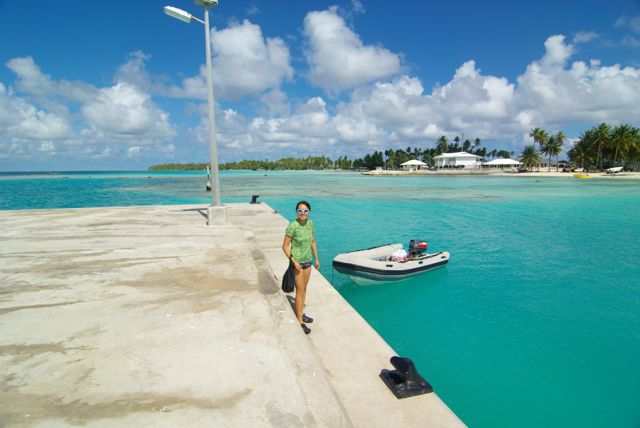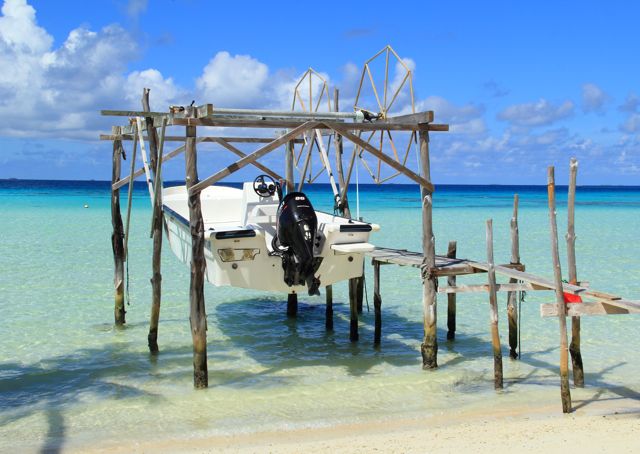We finally ventured out side of Makemo and made a trip to Raroia. As mentioned in the last post, we have become good friends with a french couple working here in Makemo, and they proposed a weekend dive trip and exploration to Raroia. We laughed a little to ourselves, as we have not planned around “a weekend” in more than 5 months, so for all those folks with Monday to Friday jobs, we have renewed empathy.
The tides were perfect for leaving Makemo Friday night, and we ran all night at slow speed to cover the 70 miles to Raroia arriving at slack tide and sunrise (5:30am). We took a quick nap and then launched the dinghy for some exploration in the village. It was curious to learn that while Makemo has 600 people and can support a doctor and nurse, Raroia has only 200 people and just has a nurses aid for medical help. As in Europe, healthcare here is provided by the government at no charge.
Entering Raroia at sunrise

Dinghy launch

Beautiful anchorage

Nice dock at Raroia.

Local transportation.

Catholic cave.

Happiness.

Boat dock at every house.

City hall.

Four of us dove twice on Saturday, and Christine and our guide made a 3rd dive on Saturday (while I mixed the Margaritas). The drift dive in Raroia is very fast with current over 5 knots, and the pass is shallow at only 30 feet deep in parts, so it is literally like flying through the Grand Canyon – underwater.
Sunday morning, we dove the wall outside the pass and saw some amazing sea life including several close encounters with the Eagle Rays, and few sharks that were fairly uninterested in Scuba divers. Following the wall dive, we headed back out for another drift dive at maximum incoming flow. It was fast (and fun), so fast we were inside the lagoon with 1500psi – so we jumped back in the dinghy and headed back out for a second dive through the pass on the same tank. (Careful with bottom time etc given the 3rd dive of the day).



Sunday night we were enjoying another perfect passage back – smooth seas, light winds, and the luxury of four crew which allowed 2 hour shifts and 6 hours of sleep. Just before Mark’s midnight shift the unthinkable happened – the Catepilar sputtered and stopped. After 5000+ miles, the sounds of silence are truly deafening. We were running fuel out of the the outboard tank and immediately suspected we ran the tank dry. I remember the instructions for priming the main engine and we began to use the hand pump to prime the primary fuel pump. After several attempts to start failed I consulted the Catepilar manual, which confirmed we were doing the right thing. Our guest suggested we pump the primer while turning the engine, and sure if after 45 minutes of silence the Big Cat roared back to life and we were underway. We will check the tank levels more carefully before leaving, and are now confident we can deal with one more of the challenges of voyaging under power.
[google-map-v3 width=”350″ height=”350″ zoom=”7″ maptype=”satellite” mapalign=”center” directionhint=”false” language=”default” poweredby=”false” maptypecontrol=”true” pancontrol=”true” zoomcontrol=”true” scalecontrol=”true” streetviewcontrol=”true” scrollwheelcontrol=”false” draggable=”true” tiltfourtyfive=”false” addmarkermashupbubble=”false” addmarkermashupbubble=”false” addmarkerlist=”-16.035,-142.467{}cruiseship.png” bubbleautopan=”true” showbike=”false” showtraffic=”false” showpanoramio=”false”]
Yup, it’s a bitch realigning those dilithium crystals!